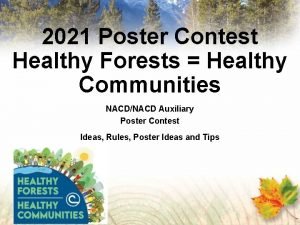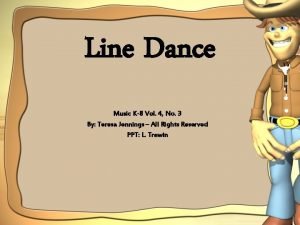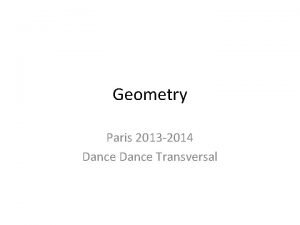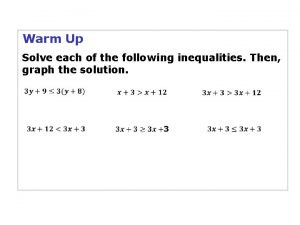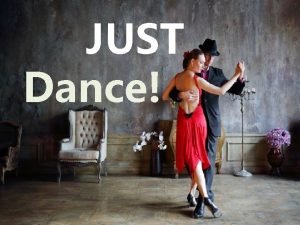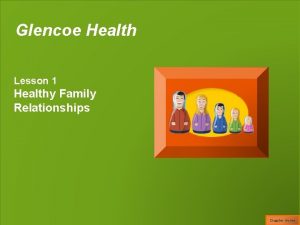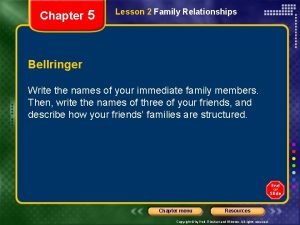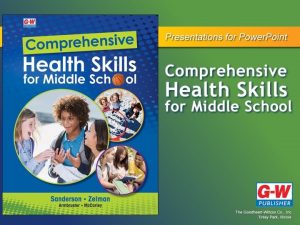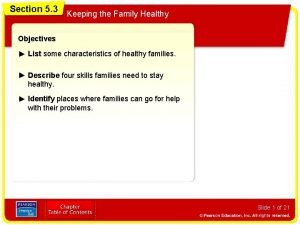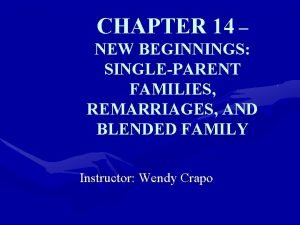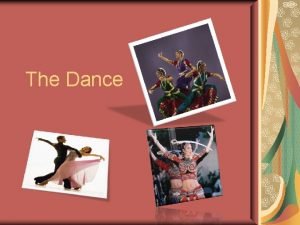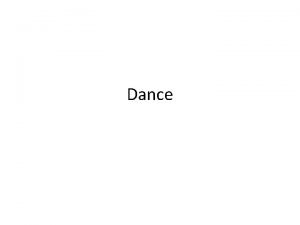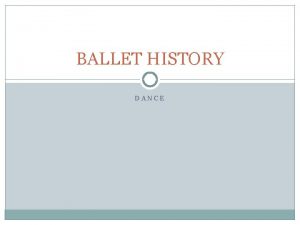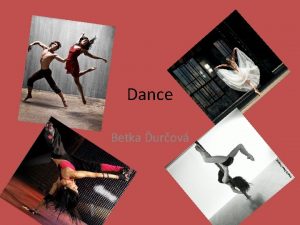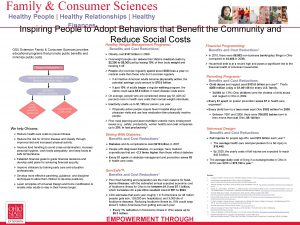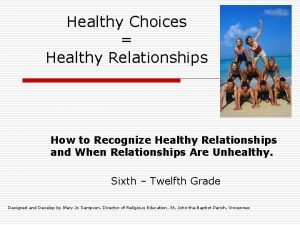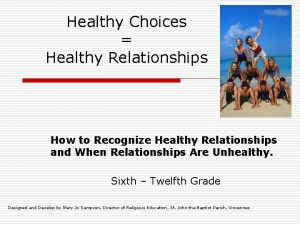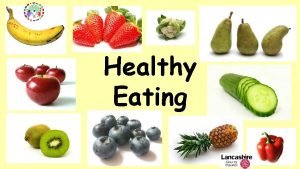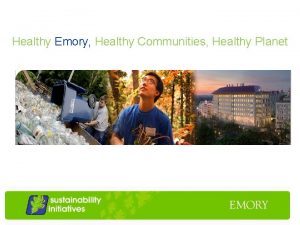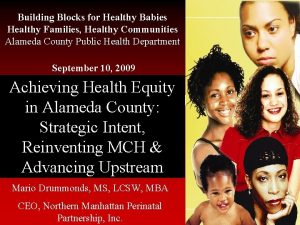FAMILY DANCE USING DANCE AS A HEALTHY FAMILY





















- Slides: 21

FAMILY DANCE! USING DANCE AS A HEALTHY FAMILY ENGAGEMENT ACTIVITY. Bradford Wiles, Ph. D. and Laura Schachtner

INTRODUCTION OF PRESENTERS

PROGRAM OVERVIEW • What is it? • Dance program for beginners • Promotion of family health and parental involvement • Scaffolding strategies • Dancing! • What do we hope to achieve? • Family health • Strong families

RESEARCH INFORMING OUR GOALS • Enjoyable time together makes families strong (University of Nebraska-Lincoln Extension, 2007. ) • Children are more physically active with parents (Rebold, Lepp, Kobak, Mcdaniel, & Barkley, 2016)

WHY ARE OUR GOALS IMPORTANT? STRONG FAMILIES/PARENTAL INVOLVEMENT • Parental involvement linked to higher reading and math scores • Organized activities also enhance academic performance (Cooper, Crosnoe, Suizzo, & Pituch, 2010) • Parental involvement also increases children’s involvement in their own learning (Zimmerman, 1990, as cited in Xu, Benson, Mudrey. Camino, & Steiner, 2010)

• Physical BENEFITS OF DANCE/PHYSICAL ACTIVITY (PA) • Weight loss • Increased fitness, energy, and strength • Psychological • Higher confidence • Positive mood changes • Behavioral • Increased physical activity at home in participants and participants’ siblings • Improved eating habits (Beaulac, Kristjansson, & Calhoun, 2011)

BENEFITS OF DANCE/PHYSICAL ACTIVITY CONT’D. • Interpersonal • More relationships • Improved social skills • Academic • Better grades • Improved homework completion (Beaulac, Kristjansson, & Calhoun, 2011)

WHY? • Why is it needed? • “A crucial determinant influencing PA is the environment in which a child lives” (Wilke, Opdenakker, Kremers, & Gubbels, 2013, p. 226) • The reach of physical activity interventions is very limited.

TEACHING COMPONENTSSCAFFOLDING • 6 strategies of scaffolding • Questioning • Explaining/Instructing • Modeling • Feedback • Maintaining focus • Structuring

SCAFFOLDING-QUESTIONING • Assessment • Yes/no/one-word answers • For example “Do you like dancing? ” • Assistance • Open-ended • For example “What do you think about dancing? ” • Practice

SCAFFOLDING-EXPLAINING AND INSTRUCTING • Parents can help their children learn by explaining what is happening • For example, “Dancing is when we move our bodies in a different way. It usually happens when there is music playing but you can dance without music too. ” • Practice

SCAFFOLDING-MODELING • Modeling occurs on 2 levels • Parents are always modeling for their children • Parents can also intentionally model specific things, such as characters out of a book or dance moves • Practice

SCAFFOLDING-FEEDBACK • Important to tell children what the feedback is about • Use “because” or explain what the feedback is for • For example “You’re doing a good job today because you’re getting up and dancing!” • Practice

SCAFFOLDING-MAINTAINING FOCUS • Adult should model their own interest • Can go along with distraction and then redirect • Offer options • Practice

SCAFFOLDING-STRUCTURING • Set the stage for what will happen • Practice

GENERAL TAP SESSION FORMAT • Greet parents and children • Welcome and introduce yourself for those who do not know you • Explain how the session will go that evening (scaffolding strategy of structuring ) • Short explanation of one of the scaffolding strategies • Teach moves • Dance

DANCE STEP PLAYLISTS • Tap Steps for All Sessions • Tap Steps - Basics

LINK FOR ALL FAMILY DANCE! RESOURCES • Family Dance!

DANCE MOVES • Stamp-https: //www. youtube. com/watch? v=y. CMkj-Li. IPQ (0: 35 -0: 50) • Step and clap-https: //www. youtube. com/watch? v=a-15 PIJNpy. E (0: 00 -0: 09) • Shuffle-https: //www. youtube. com/watch? v=7 D 582 WY 2 Et 4 (0: 00 -0: 52) • Irish-https: //www. youtube. com/watch? v=43 Uo. Z 0 a 4 c. IA (0: 00 -1: 13) • Toe drops and heel drops-https: //www. youtube. com/watch? v=_p 3 H 7 csi_A 8 (0: 001: 20) • Flap-https: //www. youtube. com/watch? v=Wcx. Rn. K 4 -r 1 s (0: 00 -0: 39)

DANCE MOVES CONT’D. • Straight kick-https: //www. youtube. com/watch? v=1 -wz. OXT_orc (0: 55 -1: 03) • Shuffle ball change-https: //www. youtube. com/watch? v=7 wmm. BLi 1 Ey. I (0: 00 -1: 41) • Buffalo-https: //www. youtube. com/watch? v=unszg. GPx. C 0 Y • Thunderstorm (run in place) • Toe tap-https: //www. youtube. com/watch? v=X 61 Yfjtjj. D 4&index=4&list=PLSc 9 h. QHu. K -PKr 2 NJf. LNMEIG 0 Bx 3 Dx. Hs. C 6 (0: 00 -0: 48)

REFERENCES • Beaulac, J. , Kristjansson, E. , & Calhoun, M. (2011). 'Bigger than hip-hop? ' impact of a community-based physical activity program on youth living in a disadvantaged neighborhood in Canada. Journal of Youth Studies, 14(8), 961 -974. Retrieved from www. scopus. com • Cooper, C. E. , Crosnoe, R. , Suizzo, M. , & Pituch, K. A. (2010). Poverty, race, and Journal of Family Issues, 31(7), 859 -883. Retrieved from www. scopus. com • Pate, R. R. , O'Neill, J. R. , Brown, W. H. , Mc. Iver, K. L. , Howie, E. K. , & Dowda, M. (2013). Top 10 research questions related to physical activity in preschool children. Research Quarterly for Exercise and Sport, 84(4), 448 -455. Retrieved from http: //search. proquest. com. er. lib. kstate. edu/docview/1651852128? accountid=11789 • Rebold, M. , Lepp, A. , Kobak, M. , Mcdaniel, J. , & Barkley, J. (2016). The Effect of Parental Involvement on Children's Physical Activity. The Journal of Pediatrics, 170, 206 -210. • University of Nebraska-Lincoln Extension. (n. d. ). Family relationships: Strong family relationships. Retrieved from http: //child. unl. edu/strongfamilies • Wilke, S. , Opdenakker, C. , Kremers, S. P. , & Gubbels, J. S. (2013). Factors influencing childcare workers' promotion of physical activity in children aged 0 -4 years: A qualitative study. Early Years: An International Journal of Research and Development, 33(3), 226 -238. Retrieved from http: //search. proquest. com. er. lib. k-state. edu/docview/1651832479? accountid=11789 • Xu, M. , Benson, S. N. K. , Mudrey-Camino, R. , & Steiner, R. P. (2010). The relationship between parental involvement, self-regulated learning, and reading achievement of fifth graders: A path analysis using the ECLS-K database. Social Psychology of Education, 13(2), 237 -269. Retrieved from www. scopus. com parental involvement during the transition to elementary school.
 We're gonna dance to one song
We're gonna dance to one song Nutrition and productivity
Nutrition and productivity Healthy soil healthy life poster ideas
Healthy soil healthy life poster ideas Healthy community poster
Healthy community poster Healthy nurse healthy nation
Healthy nurse healthy nation Electric slide steps
Electric slide steps Everybody dance and sing line dance
Everybody dance and sing line dance Dance dance transversal
Dance dance transversal Joan needed $100 to buy a graphing calculator
Joan needed $100 to buy a graphing calculator Is dancing a hobby
Is dancing a hobby Glencoe health chapter 7
Glencoe health chapter 7 Chapter 7 lesson 1 healthy family relationships answer key
Chapter 7 lesson 1 healthy family relationships answer key Chapter 7 lesson 1 healthy family relationships answer key
Chapter 7 lesson 1 healthy family relationships answer key Chapter 18 healthy family and peer relationships
Chapter 18 healthy family and peer relationships Identify four skills that families need to stay healthy
Identify four skills that families need to stay healthy Strong relationships
Strong relationships Using system.collections
Using system.collections Dtfd switch
Dtfd switch Conclusion on topic family
Conclusion on topic family Varies from family to family on the periodic table
Varies from family to family on the periodic table Characteristics of single parent family
Characteristics of single parent family Healthy lifestyle wrap up lecture
Healthy lifestyle wrap up lecture



